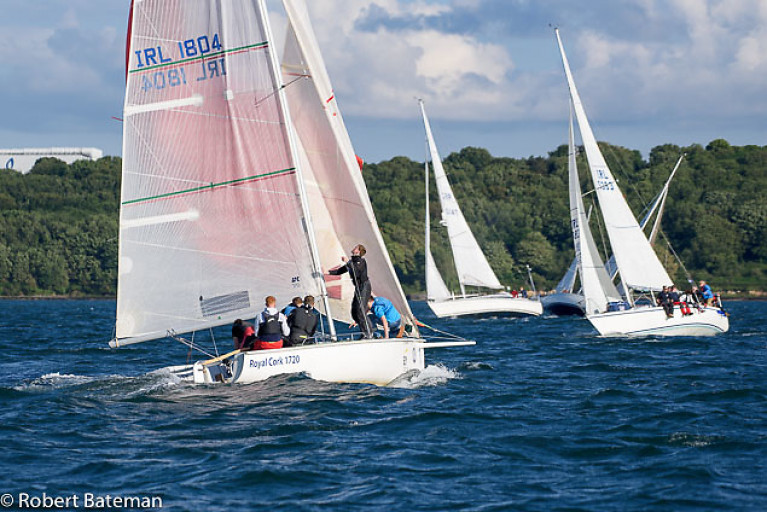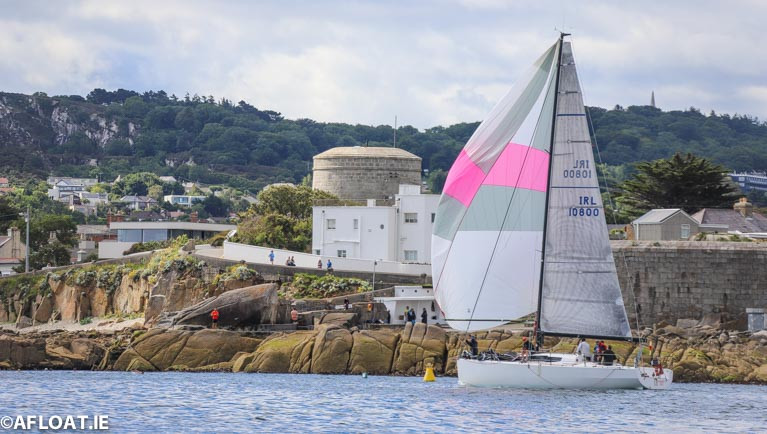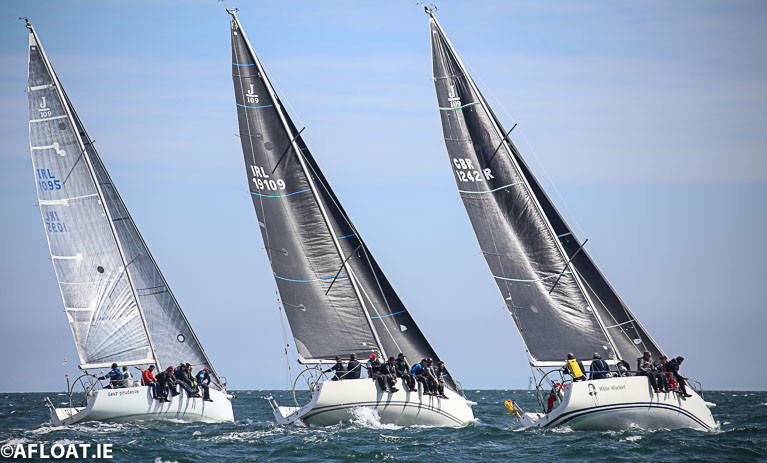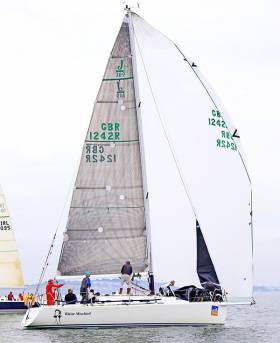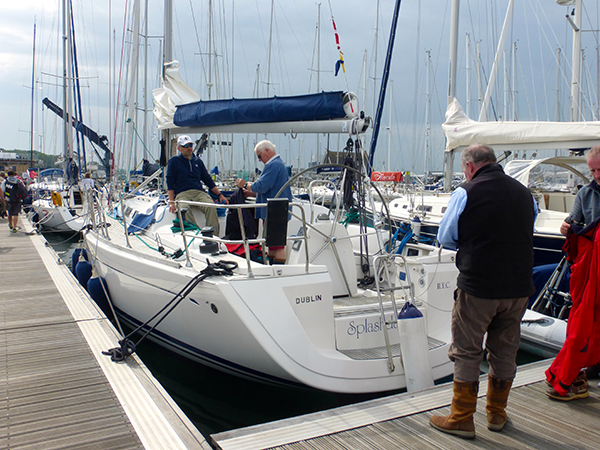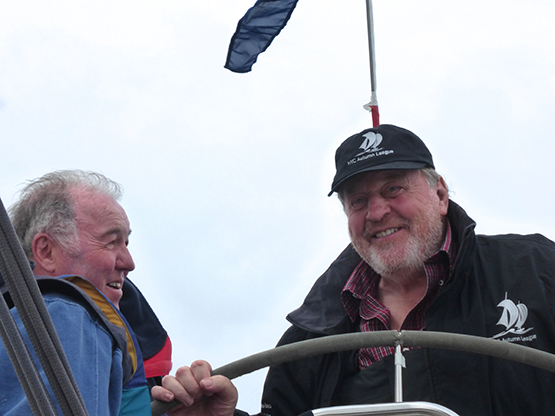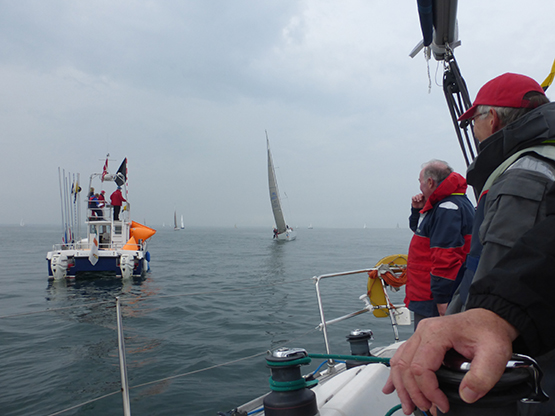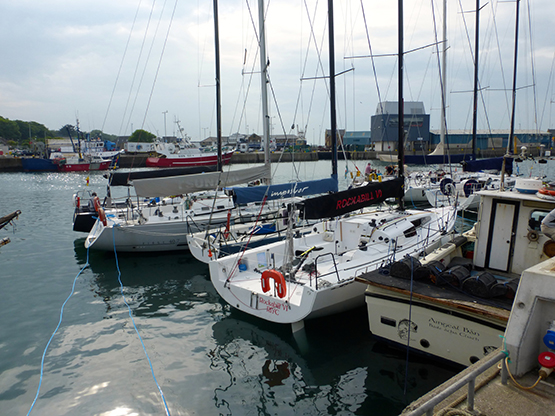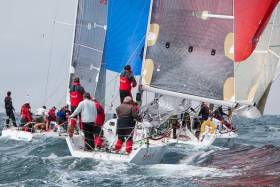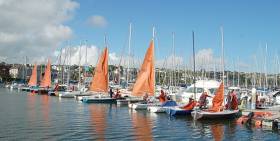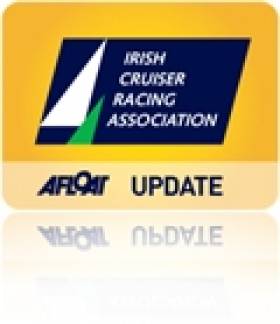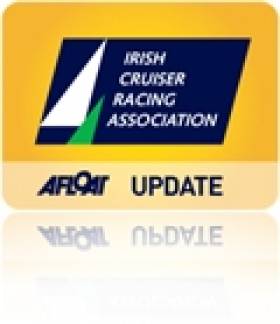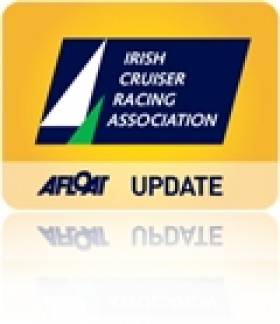Displaying items by tag: Irish Cruiser Racer Association
ICRA Plan to Increase Cruiser Racer Numbers
There will be more boats on the water in the season ahead, crewed by young sailors supported by the Irish Cruiser Racing Association's Under 25 programme which has been so successful that ICRA is now working with the national sailing organisation on developing a further stage of the project, to encourage those finishing it to buy their own boats and increase the size of cruiser fleets at clubs around the country.
"We are now seeing the positive result of what started many years ago at Howth Yacht Club in focusing on the Under 25s, which was then taken up by ICRA, by clubs around the country. It is really encouraging," Commodore Richard Colwell told me in advance of the annual general meeting of ICRA on Saturday, March 6.
Despite the unpredictability of the challenges sailing faces due to the continuing Covid 19 pandemic, he is hopeful that the season ahead will be a good one.
 ICRA Commodore, Richard Colwell - ICRA is encouraging young crews to buy their own boats and increase the size of cruiser fleets at clubs around the country
ICRA Commodore, Richard Colwell - ICRA is encouraging young crews to buy their own boats and increase the size of cruiser fleets at clubs around the country
"There may still be difficulties early in the season, but later in the Summer I am hopeful that there will be more opportunities and our national championships are well placed in September," he says on this week's podcast, where we follow up on the theme highlighted in last week's edition. This was where Daragh Connolly, the new Commodore of SCORA, the South Coast Offshore Racing Association, described the growing interest of young sailors in cruiser racing and going offshore.
 Anthony O'Leary's Antix Beag, from Royal Cork, a customised 1720 sailing Photo: Bob Bateman
Anthony O'Leary's Antix Beag, from Royal Cork, a customised 1720 sailing Photo: Bob Bateman
I started the Podcast by asking Richard Colwell how hopeful he is for the season ahead:
As previously reported on Afloat.ie, RTÉ and Met Éireann's Evelyn Cusack will head the line-up of speakers and presentations at the ICRA AGM which the Commodore will start at 10.30 am with an update. The conference will be on Zoom, due to pandemic restrictions and registration for it is open.
This will be followed at 10.40 am by Evelyn Cusack's half-hour presentation on forecasting the weather. And at 11.10 am, international yacht designer Mark Mills will give a brief talk on his line of work.
After a short break, there will be briefings on the Dun Laoghaire to Dingle Race by Adam Winkelmann, Sovereigns Cup by Anthony O’Neil, Dun Laoghaire Regatta by Con Murphy, ICRA Nationals by Ric Morris and ISORA from Peter Ryan.
ICRA Invites Under 25 Keelboat Programme Grant Applications
The ICRA/ISA Under 25 Keelboat Support Programme is open for 2021 applications.
The scheme was created as a support programme to help sailing clubs develop their own Under 25 squads and ICRA reported an overwhelming response to the initiative when launched in December 2019.
Seven clubs, from across the country, now have established U25 squads, with another two clubs actively looking for the right platform to start their own programmes.
The idea behind the programme stems from the belief that while there are a significant number of young sailors that become Irish Sailing instructors and partake in University Team Racing, ICRA says a lot simply drop out of the club racing scene in their 20s. An Under 25 keelboat development programme can offer a place for some of these sailors. Keeping them active in the sport and fostering their commitment as members of their clubs.
In the second of three years of funding for the scheme, successful applicant clubs will be provided with an initial Capital Grant which will assist clubs to buy a keelboat for their U25 squad. The scheme will then continue to provide an annual allowance to assist the club run their U25 programme until it is well established.
ICRA is now inviting Irish Sailing Category 1 clubs to send “Expression of Interest” to apply to join the programme.
Full details about the programme are here
ICRA Encourages Strong Resurgence of Irish Yacht Racing
While sailing might have been late starting, there is plenty more planned in 2020 writes ICRA Commodore Richard Colwell
After a long winter and a shut down due to COVID 19, that at one point threatened the whole sailing season, the ICRA Committee is delighted to see cruiser racing start again in clubs across the country.
Of course, it’s important that this is done within the guidelines set out by Irish Sailing and Sport Ireland so that as sailors, we remain safe and limit the possibility that our sport is impacted by or contributes to any resurgence of Covid19. To this end, we encourage the cruiser racing fraternity to familiarise themselves with the current COVID 19 regulations, follow the advice from clubs and Irish Sailing, and do our part in keeping the sport safe. Irish Sailing has produced extensive guidelines for running events which we should be helpful to anyone organising an event. Details are here
 Yacht racing leagues have returned to Cork Harbour Photo: Bob Bateman
Yacht racing leagues have returned to Cork Harbour Photo: Bob Bateman
It is great in this context to see life return to clubs across the country, with many yachts being launched in recent weeks and many more being readied. We are delighted to also see that a large number of yachts have already taken out their ECHO and IRC certificates in readiness for events that are being planned nationwide.
As you know, we were disappointed to have to cancel the ICRA National Championships originally planned to be held in tandem with Cork Week 300. However, our decision to ensure the event would take place by partnering with Howth Yacht Club’s Wave Regatta, rescheduled to 11th -13th September, means crews have time to get their boats up to speed in local racing before the National Championships take place. Details and online entry here
We already have a very strong entry for the ICRA National Championship 2020 / Wave Regatta and we would encourage all boat owners to enter what promises to be the highlight of the shortened season. We will have a number of National Championship titles up for grabs in Corinthian/White Sail, ECHO and IRC classes – with great racing planned for all levels and experience also in collaboration with ISORA.
 ISORA and DBSC racing got underway this month on Dublin Bay Photo: Afloat
ISORA and DBSC racing got underway this month on Dublin Bay Photo: Afloat
An extensive offshore sailing re-boot programme has been organised by ISORA with Peter Ryan, ICRA Committee member instrumental in its set up. A strong fleet has already taken part in its first two races with plenty more opportunities for boats to enjoy offshore racing and ensure they have suitable qualifications for the Round Ireland Race planned for later in August. Details of both are found here at www.isora.org and www.roundireland.ie
Despite the COVID 19 Lockdown, the ICRA K25 support programme has successfully started this year with a number of brand new under 25 teams set up in Sligo Yacht Club, Mullaghmore Sailing Club and Malahide Sailing Club, all with the support of ICRA grants. Many teams already in place have applied for and have received funding for continuing to run their teams and there will be plenty of opportunities for more teams to apply and take part next year.
Dublin Bay Sailing Club has also extended its season into October whilst the various regional Autumn Leagues now look to be bigger events than before.
Whilst we might have been late starting, there is plenty more sailing planned for the remainder of what looks like a longer season.
Changes to the Irish Cruiser Racing Association Rule Book for 2020
Some small changes have been made to the ICRA general rules following a successful first season under its new revamped committee and constitution.
Overall the objective of the General Rules remains the same; to help race organisers keep their documentation simple while helping competitors by keeping the detail consistent from event to event. Much of the rules remain the same with changes representing an evolution based on learning's from the 2019 season.
The statement of the fundamental principles of seamanship has been updated to bring it fully into line with the requirements of the main IRC events.
The 'confusing' use of the term ‘ICRA classes’ has been changed to ‘standard groupings’. A mechanism for reassigning boats between divisions and carrying over scores has been added.
Minimum requirements for safety equipment have been added. Again these standardize the requirements already in place at national IRC events.
Using the number of boats in a division to decide overall prizes can be seen as somewhat arbitrary. A means of calculating an Overall Score using the previous years Boat of the Year scores to assess the competitiveness of each division is provided.
Read more here
ICRA Nats First Day Is Sailing Sport For Addicts Only
If you’d brought a party of strangers to sailing out in a spectator boat to view yesterday’s first day of the three-day Irish Cruiser Racing Association’s National Championship, they could have been forgiven wondering why it all attracts such interest. There may be 86 boats entered from all over Ireland and across the Irish Sea. And yesterday evening Howth Yacht Club was fairly heaving with a spirited après sail party mood. Yet the actual sailing often moved with glacial slowness in the lightest of breezes, at times complete calm threatened, and though two of the race areas managed to complete their planned two races, the third area could only find enough breeze for one. W M Nixon tries to explain our weird sport’s special appeal.
When you’re trying to get some sort of sailing performance out of a 9-ton accommodation unit comprising three bedrooms, two bathrooms and a fully-equipped kitchen including a built-in Microwave, it does help to have a decent breeze. Yet on a day of mostly flat greyness with only the occasional flicker of sunshine at Howth yesterday, Howard McMullan’s Dufour 40 Splashdance, a handsome sailing cruiser of 2003 vintage which really does come with all mod cons, found herself struggling to find anything like adequate pressure.
Splashdance (above and below) is a Dufour 40 of 2003 vintage, and quite a hefty proposition to be racing in light airs. Photos: W M Nixon
Mossy Shanahan and Howard McMullan. Photo: W M Nixon
Yet helmsman Mossy Shanahan – who recently marked his 60th birthday by taking a celebratory spin in a World War II Spitfire fighter aircraft – got the big girl going to such good effect that his decidedly motley crew of shipmates came ashore well pleased with the day’s result in Division V (Non-spinnaker), which showed a reasonable fifth overall in Race 1, and a very cheering second overall in Race 2.
Admittedly in conditions like this where one boat can be trundling along quite happily in a private little air while another is almost dead in the water only a short distance away, there were astonishing anomalies in performance, and in our class it has to be said that a trio of Elan 333s – slippy craft perhaps, but very much cruisers nevertheless – gave all the bigger boats a very hard time, with Colm Bermingham’s Elan 333 – fresh from winning the Lambay Lady last weekend – living up to her name of Bite the Bullet by taking two wins.
With this hugely varied performance range, those who don’t find what total dinghy sailors are pleased to describe as truck-racing to be an interesting form of our sport will have found the appeal of Day One to be baffling. But it was utterly intriguing aboard Splashdance. While the hottest race boats on the other sailing areas may have leapt like racehorses with any sharpening of the feeble mostly southeast wind, our generally ponderous group took their time about getting up to speed, all manoeuvres had to be planned well in advance, and with quite a brisk tidal stream, racing marks had to be treated with the greatest respect, as all of them seemed to have somehow become magnetic overnight.
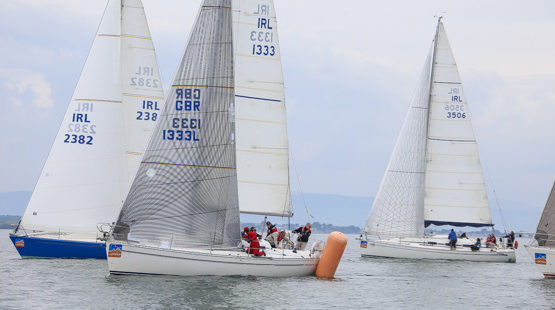
Many of the racing marks had somehow become magnetic overnight…
Yet that said, Mossy really is a demon helm, and when he had half a breeze to do what he wanted, he threw Splashdance about the starts and whatnot with stylish abandon, confidently throwing hyper-close shapes of a type I wouldn’t even dream of in a boat half the size.
Except for the rapidly-bonding band of brothers aboard the boat, it would be tedious to recount every tactic and strategy which provided such a good day’s racing in such unlikely circumstances. But as in all good stories, the best bit was at the end, over the final two miles to the finish of the second race.
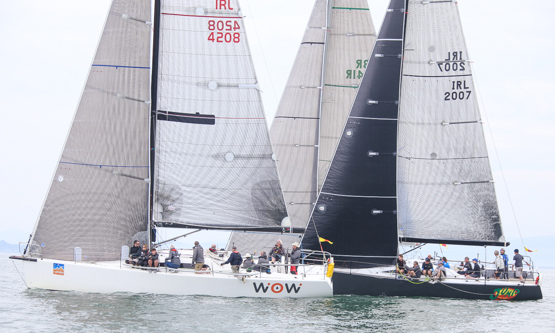
Even national champions ended up with unusual crew positions to get the right trim in the meagre breeze – George Sisk’s WOW and Conor Phelan’s Jump Juice in close contention
It had started as a beat, but somehow our tactical team of Mossy Shanahan and Roger Cagney sniffed out a backing of the wind and a sharper air to the left. They got us clear to the left of a group of other boats, and though Bite the Bullet was by this time well ahead, having never out a foot wrong at any stage, we were mixing it with the other two Elan 333s, the Sigma 38 Spellbound, and the XC 45 Samaton (Robert Rendell), with the potentially fastest boat in the class, Vincent Farrell’s First 40.7 Tsunami, seemingly untouchable in front.
Did we really do that? Splashdance’s crew look aft in wonder as the First 40.7 Tsunami comes to the finishing line astern of them. Photo W M Nixon
But suddenly, slightly out on the left, Splashdance tasted magic. She found the groove. She just upped and went, dropping the others and then rolling insouciantly over Tsunami as though it was the sort of thing she did every day. Maybe it is. All I know is that it was a bit of sailing which took her neatly to the finish, and left her entire crew on a high which was only further augmented by our demon driver then reversing the big lady into her very tight inner corner berth in the marina through the seemingly impossible gap created by visiting boats rafted up.
In fact, visiting boats are finding berths wherever they can in this busy weekend in Howth, and an abiding memory from yesterday evening is the sight of some of the more legendary craft in the contemporary Irish offshore scene, yachts of the calibre of Jump Juice, WOW and the new Rockabill IV, rafted up in traditional style outside fishing boats in the fish dock, while at the head of the dock the new state-of-the-art fisheries pontoon is properly providing the full facilities for Howth’s growing fleet of small fishing craft, which is just as it should be.
The new JPK 10.80 Rockabill VI (Paul O’Higgins) finds herself an unusual berth in Howth. Photo: W M Nixon
Working life goes on – there may be top offshore racers in port, but at Howth’s new pontoon for small fishing craft, lobster pots still need to be cleaned with a powerhose. Photo: W M Nixon
Certainly when I met up with ICRA Commodore Simon McGibney of Foynes, he’d no complaints, as they’d obligingly provided late crane facilities on Thursday night after his J/24 had been delayed on the way up from the west. But then like everyone else, I suppose he was delighted with the fact that an almost complete programme had been put through, for yesterday’s wind forecasts suggested we might have been plagued by calm all day.
ICRA Commodore Simon McGibney of Foynes YC in Howth yesterday. Photo: W M Nixon
The wind prospects for today and tomorrow are a little better, but there’s definitely no danger of any race being blown out, though there may be a deluge or two. As it is, the race officer teams deserve every credit for pulling a day’s sport out of light airs yesterday, and going into Day 2 the leaders are Jump Juice (Conor Phelan RCYC) in Division 0, White Mischief (T & R Goodbody RIYC in Division 1,) The Big Picture (M & R Evans HYC) in Division 2, Hard on Port (Flor O’Driscoll, RStGYC) in Division 3, OctopussE (Patrick O’Neill HYC) in Division 4, and Bite the Bullet (Colm Bermingham) in Division V.
The story behind the leaderboard is that Tim Goodbody is putting his imprint on the J/109s as surely as he put it on the Sigma 33s and the J/24s and the Dragons before that, another story is that the J/24s are providing one of the most heartening revivals in 2016, as Flor O’Driscoll’s Hard on Port is only one of several J/24s which are having themselves a ball. As for the news that The Big Picture currently leads Division 2, that means she leads the hyper-hot Half Tonners, so whatever Alan Power did to the Evans brothers’ boat in recent months in his shed up the back of Malahide (see SailSat 21st May), it undoubtedly is all to the good.
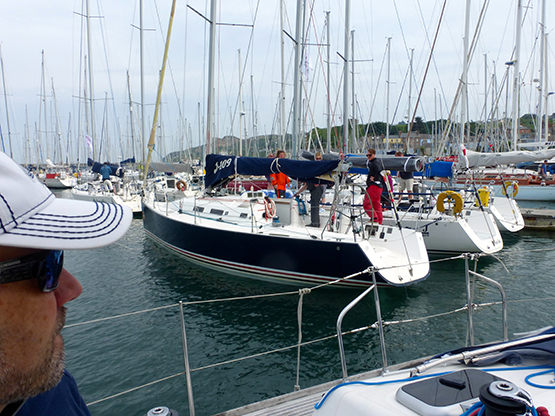
Some of the eleven J/109s which have entered for the ICRA Nats 2016 in Howth. Photo: W M Nixon
But even for those not hitting the headlines, the ICRA Nationals 2016 are a reminder that in the final analysis, sailing is all about people sharing enthusiasm for a curious vehicle sport which provides great pleasure in sometimes unlikely circumstances. Going down to join Splashdance yesterday morning in virtually lifeless weather, it was difficult not to wonder what it’s all about. Yet somehow it was absorbing entertainment from beginning to end. My thanks to Howard McMullan and Mossy Shanahan and Roger Cagney and the rest of the gang, who were David Will and Paddy McCaughey of Howth, John Ives of Sutton, and Liam MacMahon of Skerries, good shipmates every one of them.
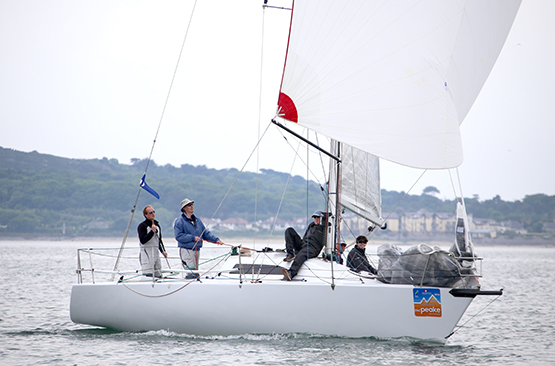
The Big Picture is in clear focus. Michael and Richard Evans’ Half Tonner currently leads both the Classic Half Ton Class and Division 2
Read also:
Day One Report: Goodbody Takes Class One Lead At ICRA Nationals
Dublin Yacht Clubs Boast Biggest Entry At ICRA Nationals, Light Winds Forecast At Howth
Howth Yacht Club Lambay Race Was ICRA Nationals Form Guide
ICRA Nats In Howth Yacht Club Will Attract The Cream Of The Fleets
To say that Irish sailing’s programme in June 2016 is crowded is a massive understatement. It’s a month which needs at least two extra weekends. Yet with only four available, sailors have to make hard choices, both as to where they’ll be competing, and when. W M Nixon tries to make some sense out of it.
There’s no doubting that special buzz in the air. The mood is good. It’s farewell to recession, and hello to more sailing than we can cope with. But even so, with only four weekends in June, and with the weather forgetting for the moment that this is Ireland and not one of the better sailing areas in the Greek islands, we might well dream of grabbing the opportunity while it offers. Carpe Diem. Seize the Day. For the winter will be long. And damp. And grey.

Paul O’Higgins’ new JPK 10.80 Rockabill VI. She is expected to be one of the star turns in the ICRA Nats at Howth in six days’ time
But in today’s world, you simply don’t bunk off for unlimited time as folk did in times past. The reality is that top crew just can’t do everything in the essentially amateur environment and crowded programme which is Irish sailing, and in a busy year there is only so much an amateur sailor can participate in while continuing to fulfill professional and domestic duties.
Thus we’re looking at an ICRA Nationals in Howth Yacht Club in six days’ time (Friday June 10th to Sunday June 12th) which will do well to get total entries over the eighty mark. Doom merchants reckon that Irish sailing should be looking to have a hundred boats in the cruiser fleet at the Nationals in order to indicate full health. It’s not a view I share. This is a good fleet when you consider that they exclude one designs such as the locally-based Puppeteer 22s and the J/80s, and then add in the fact it’s one very crowded month.
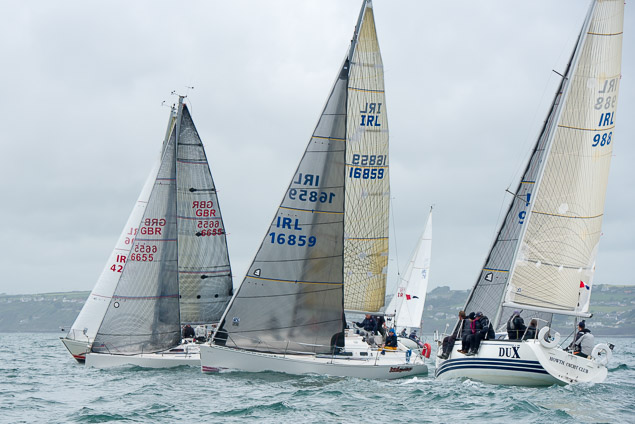
Summertime in Howth – this is the HYC upper deck in uncrowded mode. Photo: Courtesy HYC
As it is, in Howth they already have the annual Lambay Race today, which quite an event in its own right, while last night ISORA’s Dun Laoghaire to Douglas IOM race went off as planned. And then in a fortnight’s time the entire island is holding its breath waiting for the start at 1300hrs on Saturday June 18th at Wicklow of the Volvo Round Ireland Race 2016. This has virtually doubled its entries on the turnout of 2014, and with biggies like Rambler 88 and the MOD 70s involved, it is simply dominating the entire sailing month.
So the remarkable thing about the ICRA Nationals is that though they’ll conclude with basically just a couple of days to go to the start of the countdown to the Round Ireland in Wicklow and Dun Laoghaire, there’ll be crew and boats racing at Howth like there’s no tomorrow. But when tomorrow comes, they’ll be busy re-inventing themselves as new crews with fresh boats and different livery for the Volvo Round Ireland.
Top of the list in this particular quick-change scenario is the Dave Cullen crew with current Half Ton Classic World Champion Checkmate XV. With a good turnout of Half Tonners lined up for Howth, it’s expected that Checkmate will avoid last year’s slip-up in the ICRA Nationals in Kinsale, when they somehow allowed the lead to be snapped up at the end by Ross McDonald's X–332 Equinox. Jonny Swan's Half–Tonner Harmony was third in Kinsale and is racing again in Howth. Added to this Half Tonner line–up in 2016 is Mike and Ritchie Evan's Big Picture, the recent Half Ton winner at HYC's nine race Sportsboat Cup.
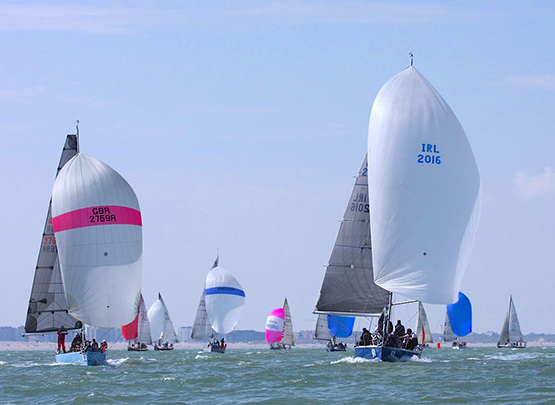
Dave Cullen’s Checkmate leading the fleet in the Half Ton Classic Worlds 2015 in Belgium
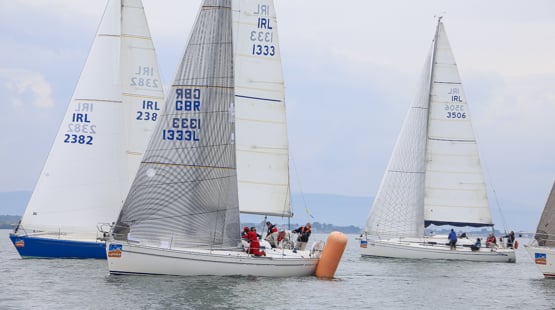
All the usual suspects…..Dave Cullen and the Checkmate crew after winning the Half Ton Worlds in August 2015
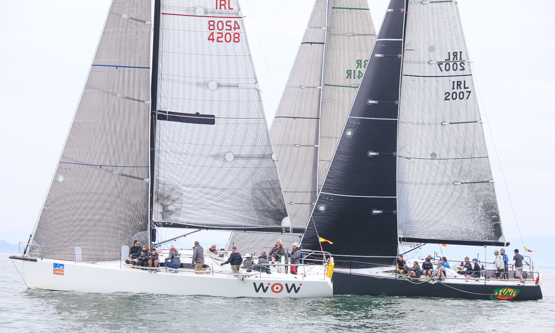
The J/109 Storm in full cry with the Kelly family in charge as usual. But immediately after the ICRA Nationals, she’ll become Euro Car Parks for the Volvo Round Ireland race, with Dave Cullen as skipper.
But regardless of the outcome, the ICRA Nats will have scarcely been put to bed when Cullen and his team re-direct their thoughts to the Volvo Round Ireland, for which they’ve chartered the Kelly family’s J/109 Storm, which will race round Ireland as Euro Car Parks and will have the already high-powered Cullen squad further reinforced by the addition of Maurice “Prof” O’Connell.
All this metamorphosis will be taking place only ten days hence, but by that time a significant array of questions will have been answered about just which Irish cruiser-racers are going best this year. For regardless of numbers, the fact is the lure of a National title really does draw in some very capable crews well able for the top level in the ICRA Championships.
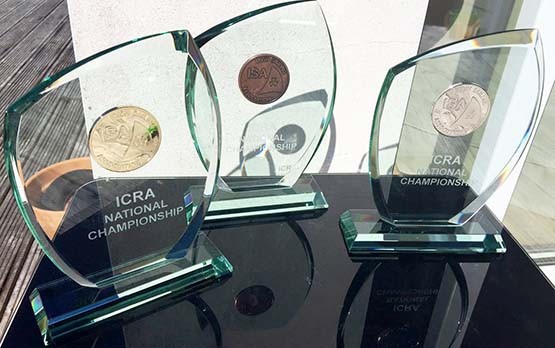
The attractive array of trophies for the ICRA Nats 2016 include embedded medals to remind us that the winners will indeed be National Champions. Photo courtesy ICRA
And in Howth in six days time, much of the interest is going to focus on the lineup of at least nine J/109s, which will be providing some of the best racing available. It’s a dream scenario in terms of sporting potential, as John Hall’s Something Else is fresh home from Scotland with the class win recorded in the Silvers Scottish Series, J/109 newby Tim Goodbody (a Fastnet Race overall win is only one item in his stellar career) is already rising through the J/109 ranks with bullets recorded in this year’s Dublin Bay racing, and he’s convinced there’s a lot more speed to be found in the newest White Michief, and current ISORA Champions the Shanahan family will be there to help him find it with their hyper-successful J/109 Ruth.
Further raising the ante on the J/109 pace will be John Maybury’s Joker, winner in Kinsale last year. As for the Kelly family of Rush Sailing Club, they may be handing over their beloved Storm to the tender care of Dave Cullen and his gang for the Volvo Round Ireland, but as former ICRA Boat of the Year, Storm is going to be very much the Kelly boat, racing as hard as she can under the Kelly colours in six days’ time.
But there is of course much of interest beyond the virtually one design cut-and-thrust of the J/109s, not least in Class 1 where the 2015 Boat of Year WOW (RIYC), George Sisk’s Farr 42 from Dun Laoghaire, is competing.
We don’t have to tell you that the JPK 10.80 won last year’s Rolex Fastnet Race and was right in the frame in the Rolex Sydney-Hobart, but for the O’Higgins crew the fascination will lie in getting to grips with the very commodious JPK 10.80, because for many seasons they’ve successfully campaigned the Corby 33 Rockabill V, for which several adjectives might spring to mind, but “commodious” would not be one of them.

Ross MacDonald’s X332 Equinox was top scorer at Kinsale last year, and will be aiming for a similar performance in her home waters next week. Photo: W M Nixon
Other winners from the ICRA Nats 2015 in Kinsale include Ross MacDonald’s veteran X332 from Howth. Having been in the fray a week ago with his wife Aoife on the 1720 Atara during the Howth Sportsboat Cup series where a first day lead slipped away from them, he’ll be keen to show that Equnox won’t be similarly eclipsed a week hence.
As it happens, the Howth squad - with their headquarters boisterously established in Kinsale’s White Lady Inn – were very much a force to be reckoned with in all classes in the 2015 championship, and another defender back on home water will be the decidedly senior yet still very competitive Ron Holland-designed Club Shamrock Demelza (Windsor Laudan & Steffi Ennis), which swept the board in Non-Spinnaker Class 6, while clubmate Colm Bermingham with the Elan 330 Bite the Bullet did the same in Class 5.
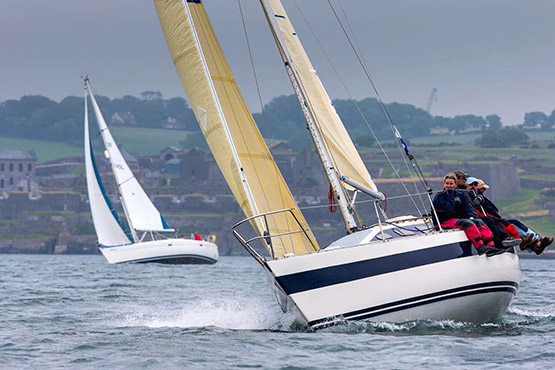
The Club Shamrock Demelza is now pushing forty years of age, yet owners Windsor Laudan and Steffi Ennis were champions at the ICRA Nats 2015 in Kinsale. Photo courtesy ICRA
However, the very fact of sailing an away series seems to bring out an bit of extra competitive edge in many crews, and in taking an overview of the fleet for the ICRA Nationals 2016, we might find that some of the smart money is on Rob McConnell’s A 35 Fool’s Gold from Dunmore East, and Conor Phelan’s Ker 36.7 Jump Juice from Crosshaven.
Both crews have a fine record of success, and both are renowned for their enthusiasm and sportsmanship. And in the case of Jump Juice, she has already won her class in this year’s RORC Easter Challenge. Not bad going for a boat which has always seemed as new as tomorrow, yet this year she’ll be ten years old.
But that’s only at the very sharp end of the fleet. The Secret Ingredient of the Irish Cruiser-Racing Association is the Progressive ECHO handicap system, which re-rates each boat after every race. Everyone is in there with a chance. Inevitably, this approach was dismissed by purists as “encouraging mediocrity” when it was first introduced. But it has in fact encouraged new levels of enthusiasm, which in time lead on to markedly improved performance. “Tomorrow is another day” could well be the motto for Progressive ECHO, and we’ll see how well it works as the ICRA Show swings into action at Howth next Friday.
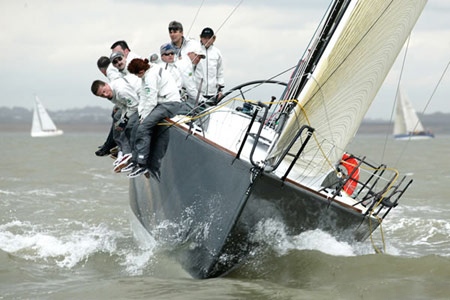
The great Jump Juice as she was at her debut ten years ago. She is still very much a contender
Read also: ICRA Publish National Championship Divisions for Howth Yacht Club Event
ISA Tries To Get Rid Of Elitism In Sailing
I have been vocal over the past few months in expressing concern about improving access to sailing and combating the impression that the sport is elitist. I spoke about the need for initiatives at the annual conference of the Irish Cruiser Racing Association in Limerick and at the annual meeting of the South Coast Offshore Racing Association in Kinsale. Scroll down to listen to the podcast below.
While both are racing-focussed organisations they were the two which offered an opportunity to raise the subject and credit to them for doing so. Both meetings acknowledged the need for increasing recruitment into the sport and the difficulties experienced in many clubs of holding onto members and crewing cruisers for racing. And issues were raised as to whether clubs and boat owners were sufficiently welcoming to potential newcomers, whether the cost of memberships was too high and whether there was too much emphasis on racing and the ‘fun’ element of the sport had been lost.
There is more to sailing than the competitive aspect and more also than cruiser racing. However, dinghy fleets, while having less of a ‘numbers’ requirement to sail boats, have also been experiencing the need to ensure their future and they share a common desire to increase club memberships and active sailors.
So I am glad to see the response of the Irish Sailing Association in the launching of the TRY SAILING programme. The official launch will be on Monday next, Bank Holiday Monday in Kinsale Yacht Club in Co.Cork at 1p.m. where a number of schools and groups with disabilities from the local area are going to do a ‘try sailing’ session.
Ciaran Murphy, the ISA Regional Development Officer, specialising in Access and Participation, is leading the Try Sailing initiative. He was Manager of Lough Derg Yacht Club before joining the Irish Sailing Association. On this week’s THIS ISLAND NATION PODCAST, I discuss its purpose, where and how it will be implemented and whether it will eradicate that impression of elitism.
There may be some expense involved in training programmes, but at a low cost and there are other opportunities being offered alongside TRY SAILING, such as the CREW POINT which a number of clubs have committed to trying this season to encourage potential newcomers to approach clubs directly on sailing days and evenings.
Combined, these are encouraging new approaches to increasing interest in sailing.
Key Sailors to be Invited to New Format ICRA Conference
#ICRA – Irish Cruiser Racing Associaton (ICRA) chief Barry Rose is to personally invite key individual sailors to participate in a new format for November's annual conference in Kilkenny.
The aim is to to encourage much greater participation by all present. Instead of a top table facing ranks of chairs/attendees ICRA are going for a 'round table' layout and are expecting to boost its regular 50 member turnout.
The line up for the event includes Olympic race officer Jack Roy and some other speakers yet to be announced.
'The people we want on this list come under a number of headings; regular competitors in the national championships, regular attendees at previous conferences, people who have set up new/interesting initiatives in cruiser sailing and perhaps most importantly, people who have something to say,' says the association's Denis Kiely.
Rose wants to get a spread of sailors from all parts of the country to participate. The conference is at the Newpark hotel in Kilkenny on November 17, 2012.
Kilkenny ICRA Conference to Feature Olympic, Quarter Ton & Discard Discussion
#icra – November's Irish Cruiser Racer Conference (ICRA) in Kilkenny on November 17th will feature reports from the Olympic Games from Dun Laoghaire race officer Jack Roy who officiated in Weymouth, ICRA will also propose a new youth sailing academy and Ian Travers will report on the rise and rise of the Quarter ton fleet.
The packed one day conference is an opportunity for all cruiser racing sailors to exchange views and engage on all issues that are important to sector. All cruiser sailors are automatically members of ICRA and are very welcome.
The conference will also see the presentation of ICRA's boat of the year award. Nominations are invited.
A discussion on the issue of discards at the 2013 ICRA National Championships at Tralee Bay Sailing Club at Fenit will also take place.
Options for the biggest cruiser event of the year include one discard after six races are sailed or the last race is non discardable as has been the case for last two years or that championships becomes a non discard event.
The Kilkenny conference at the Newpark hotel will review the 2012 Nationals at Howth and it will include a presentation of a professional survey carried out by Richard Colwell.
ICRA will propose ideas for development of a Sailing Academy to encourage participation of young sailors in major International events.
Ian Travers will make an interesting and informative presentation on developments in small boat sailing including recent progress of the quarter ton class and his experience of restoring a leading edge quarter tonner.
Jack Roy recently returned from Race officer duties at Olympics will share his experience and offer the opportunity to engage with a leading Race Officer on issues of relevance to racing sailors.
There will be an update of developments on Brewin Dolphin Commodores Cup and Ireland's efforts to field a team for the next event in 2014.
There will be an update on the new system of nomination for places at ISA all Ireland sailing Championships and how it impacts on ICRA National Championship Winners.
ICRA also hope to announce a further speaker shortly.
The ICRA conference is always a good day out where all those attending are encouraged to engage and air their views over the day.
Ireland's Final Plea to Defend Commodore's Cup
#COMMODORE'S CUP – The Irish Cruiser Racing Assocation (ICRA) has issued a final plea to any skippers interested in defending the Commodore's Cup Ireland, first won in 2010, to come forward amid speculation that Ireland's hopes of mounting the defence are now unlikely.
With less than three months remaining before the event, puttng together three crews (nearly 50 sailors) plus shore and team support would be extremely late but ICRA is still interested in pulling a rabbit out of the hat even with a view to building early support for a 2014 campaign for Cowes.
The Commodores Cup takes place from 21st to 28th July.
As far back as last October ICRA was still confident it would be able to mount a successful defence given it had taken the team four attempts to win the prestigious cup, the world championships of the cruiser racer fleet.
It is likely the 2010-winning team captain Anthony O'Leary would again be competing with his Ker 39 Antix from the Royal Cork Yacht Club. In October O'Leary told Afloat: 'We finally won this great event in 2010 with a well organised campaign, let's hope we can return to defend it in 2012 learning further from that experience'.
Given the limited time remaining the association has now issued its final call for potential candidates not already in discussions with ICRA to get in touch to discuss their plans for the forthcoming event. ICRA stresses it welcomes discussions with all interested potential Irish team and team members, including those representing regional, youth, or other interests.




























